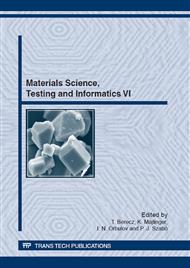[1]
J. Robertson, Mater. Diamond-like amorphous carbon, Sci. Eng. R. Rep. 37 (2002) 129-281.
Google Scholar
[2]
A.A. Voevodin, S.V. Prasad, J.S. Zabinski, Nanocrystalline carbide/amorphous carbon composites, J. Appl. Phys. 82 (1997) 855-858.
DOI: 10.1063/1.365784
Google Scholar
[3]
D. Klaffke, A. Skopp, Are thin hard coatings (TiN, DLC, diamond) beneficial in tribologically stressed vibrational contacts—Effects of operational parameters and relative midity, Surf. Coat. Technol. 98 (1998) 953-961.
DOI: 10.1016/s0257-8972(97)00387-3
Google Scholar
[4]
J. Patscheider, T. Zehnder, M. Diserens, Structure–performance relations in nanocomposite coatings , Surf. Coat. Technol. 146–147 (2001) 201-208.
DOI: 10.1016/s0257-8972(01)01389-5
Google Scholar
[5]
T. Vitu, T. Polcar, L. Cvrcek, R. Novak, J. Macak, J. Vyskocil, A. Cavaleiro, Structure and tribology of biocompatible Ti–C: H coatings, Surf. Coat. Technol. 202 (2008) 5790–5793.
DOI: 10.1016/j.surfcoat.2008.06.040
Google Scholar
[6]
R. Hauert, A review of modified DLC coatings for biological applications, Diamond Relat. Mater. 12 (2003) 583-589.
DOI: 10.1016/s0925-9635(03)00081-5
Google Scholar
[7]
A. Grill, Diamond-like carbon coatings as biocompatible materials—an overview, Diamond Relat. Mater. 12 (2003) 166-170.
DOI: 10.1016/s0925-9635(03)00018-9
Google Scholar
[8]
Y. Wang, X Zhang, X. Wu, H. Zhang, X. Zhang, Compositional, structural and mechanical characteristics of nc-TiC/a-C: H nanocomposite films Appl Surf Sci 255 (2008) 1801–1805.
DOI: 10.1016/j.apsusc.2008.06.020
Google Scholar
[9]
A.A. El Mel, B. Angleraud, E. Gautron, A. Granier, P.Y. Tessier, XPS study of the surface composition modification of nc-TiC/C nanocomposite films under in situ argon ion bombardment, Thin Solid Films 519 (2011) 3982–3985.
DOI: 10.1016/j.tsf.2011.01.200
Google Scholar
[10]
K. Sedlackova , T. Ujvári, R. Grasin, P. Lobotka, I. Bertoti, G. Radnoczi, C–Ti nanocomposite thin films: Structure, mechanical and electrical properties, Vacuum 82 (2008) 214-216.
DOI: 10.1016/j.vacuum.2007.07.055
Google Scholar
[11]
Y. Kusano, I.M. Hutchings, Analysis of nano-indentation measurements on carbon nitride films Surf Coat Technol 169-170 (2003) 739-742.
DOI: 10.1016/s0257-8972(03)00132-4
Google Scholar
[12]
W.C. Oliver, and G.M. Pharr, An improved technique for determining hardness and elastic dulus using load and displacement sensing indentation experiments, J. Mater. Res. 7 (1992) 1564-1583.
DOI: 10.1557/jmr.1992.1564
Google Scholar
[13]
K. Sedláčková, P. Lobotka, I. Vávra, G. Radnóczi, Structural, electrical and magnetic properties of carbon–nickel composite thin films, Carbon 43 (2005) 2192 - 2198.
DOI: 10.1016/j.carbon.2005.03.035
Google Scholar
[14]
D. Martínez-Martínez, C. López-Cartes, A. Fernández, J.C. Sánchez-López, Comparative performance of nanocomposite coatings of TiC or TiN dispersed in a-C matrixes, Surface & Coatings Technology 203 (2008) 756–760.
DOI: 10.1016/j.surfcoat.2008.08.064
Google Scholar
[15]
M. Stüber, H. Leiste, S. Ulrich, H. Holleck, D. Schild, Microstructure and properties of low friction TiC–C nanocomposite coatings deposited by magnetron sputtering, Surface & Coatings Technology 150 (2002) 218–226.
DOI: 10.1016/s0257-8972(01)01493-1
Google Scholar
[16]
J. Neidhadrt, Z. Czigány, I.F. Brunell, L. Hultman, Growth of fullerene-like CNx thin solid films by reactive magnetron sputtering; Role of low energy ion irradiation in determining microstructure and mechanical properties. , Appl. Phys. 93 (2003).
DOI: 10.1063/1.1538316
Google Scholar
[17]
K. Sedláčková, R.O. Grasin, T. Ujvári, I. Bertóti, G. Radnóczi, Carbon-metal (Ni or Ti) nanocomposite thin films for functional applications, Solid State Sciences, 11(10) (2009) 1815-1818.
DOI: 10.1016/j.solidstatesciences.2009.05.018
Google Scholar
[18]
K. Sedláčková, R.O. Grasin, G. Radnóczi, Carbon - Metal (Ni, Ti) nanocomposite films as protective coatings, In LM. Krause (Eds. ), New Research on Nanocomposites, Nova Science Publishers Inc., New York, 2008, pp.223-246.
Google Scholar
[19]
S. Zhang, X.L. Bui, J. Jiang, X. Li, Microstructure and tribological properties of magnetron sputtered nc-TiC/aC nanocompositeSurface & Coatings Techn. 198 (2005) 206-211.
DOI: 10.1016/j.surfcoat.2004.10.041
Google Scholar


